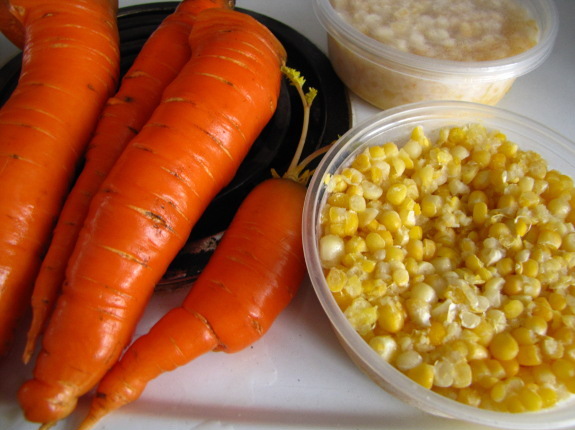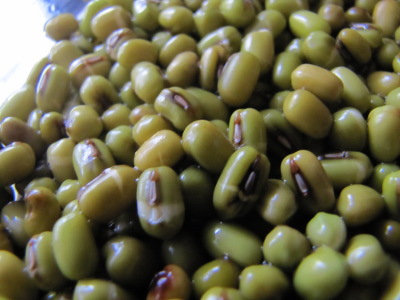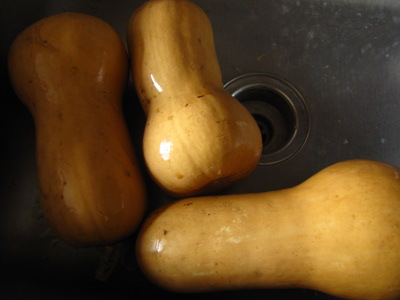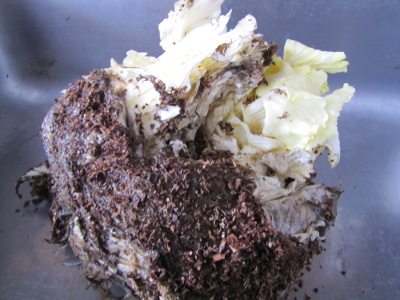
Still eating fresh vegetables in February

This has been our
tastiest winter yet, especially when you consider the vegetables we're
still eating fresh.
 When the snow and freezes
allow access, we're harvesting as many greens as we can eat out of the quick
hoops, although the
lettuce is starting to fade. Arugula has turned out to be a
quality winter salad green, growing faster than the lettuce and holding
up to colder weather, plus the sweet, spicy leaves are delicious when
they make up about 10% of a salad. I'd say we planted just the
right amount of lettuce (three beds) and arugula (one bed), and
actually grew too much kale (six beds under cover and fifteen more beds
of kale and other greens uncovered). (In case you're keeping
track at home, I use "bed" to mean an area about 18 square feet in
size.)
When the snow and freezes
allow access, we're harvesting as many greens as we can eat out of the quick
hoops, although the
lettuce is starting to fade. Arugula has turned out to be a
quality winter salad green, growing faster than the lettuce and holding
up to colder weather, plus the sweet, spicy leaves are delicious when
they make up about 10% of a salad. I'd say we planted just the
right amount of lettuce (three beds) and arugula (one bed), and
actually grew too much kale (six beds under cover and fifteen more beds
of kale and other greens uncovered). (In case you're keeping
track at home, I use "bed" to mean an area about 18 square feet in
size.)
Brussels
sprouts have been a
major boon, especially because they're tall enough that I can harvest
the little heads through a deep snow. We didn't grow nearly
enough, with only one bed in full production and three beds finally
starting to bear from their shadier spot in the front garden.
Next year, we'll put more plants in the sun as this variety moves off
our experimental list and onto our list of mainstays.
 That's
it for the crops we're still harvesting out of the garden, except for
bits of Egyptian onions, thyme, parsley, and celery. But our
other stores are also doing admirably. The queen has been carrots, which have held up
perfectly in the fridge
root cellar (where they returned after a
week on the kitchen floor
covered by a towel during the coldest spell in January). We've eaten
fresh carrots, carroty soups, given away bagsful, and still have plenty
to carry us through until the spring crop. If anything, we could
probably get away with planting a little less than six beds next year,
but we'll probably hold steady.
That's
it for the crops we're still harvesting out of the garden, except for
bits of Egyptian onions, thyme, parsley, and celery. But our
other stores are also doing admirably. The queen has been carrots, which have held up
perfectly in the fridge
root cellar (where they returned after a
week on the kitchen floor
covered by a towel during the coldest spell in January). We've eaten
fresh carrots, carroty soups, given away bagsful, and still have plenty
to carry us through until the spring crop. If anything, we could
probably get away with planting a little less than six beds next year,
but we'll probably hold steady.
We haven't eaten as many
butternuts as in previous years because we mostly consume them in
butternut pies, which depend on good eggs, and we've started eating
eggs for breakfast, so we're perennially short. The stems are
beginning to go a bit hollow and imperfect squashes are starting to
rot, so I'm roasting up the many we have remaining to go in the
freezer. I'd say we should grow many fewer butternuts next year,
but if we increase our egg supply, that might not be true, and chickens
adore the seeds.
 We ate the last cabbage out
of the fridge root cellar last week, and it wasn't a pretty
sight. I suspect cabbages would like it just a hair warmer than
carrots, or perhaps they just don't have as much keeping power, because the last cabbage
split open and started to grow a new head from the crack. We'll
grow the same amount this year because I clearly haven't entirely got a
handle on the crop, but I suspect we may scale up at a later date.
We ate the last cabbage out
of the fridge root cellar last week, and it wasn't a pretty
sight. I suspect cabbages would like it just a hair warmer than
carrots, or perhaps they just don't have as much keeping power, because the last cabbage
split open and started to grow a new head from the crack. We'll
grow the same amount this year because I clearly haven't entirely got a
handle on the crop, but I suspect we may scale up at a later date.
Of course, we've still
got garlic and sprouting beans and white potatoes (the last of which we
hardly eat), though we're a bit low on sweet potatoes (due to this
recipe increasing
our consumption). And then there's the contents of the freezer,
which seem to be holding up very well despite us eating soup about once
a day. While I won't mind fresh asparagus at all once April rolls
around, I don't think we'll be craving it quite as hard as we have in
the past.
Want more in-depth information? Browse through our books.
Or explore more posts by date or by subject.
About us: Anna Hess and Mark Hamilton spent over a decade living self-sufficiently in the mountains of Virginia before moving north to start over from scratch in the foothills of Ohio. They've experimented with permaculture, no-till gardening, trailersteading, home-based microbusinesses and much more, writing about their adventures in both blogs and books.
Want to be notified when new comments are posted on this page? Click on the RSS button after you add a comment to subscribe to the comment feed, or simply check the box beside "email replies to me" while writing your comment.

Hi Anna,
Very nice post as usual :).
I wonder how many pounds of the various things you stored are needed to make it through?
Without any real data, I concluded that 1 pound per person per day was about right? But I didn't address how much of which veggies and other stuff.
I really gotta get setup to duplicate your greens under hoops. Sounds simple and effective. Maybe a page describing and duplicating it for simple folks like me :)?
I would get into measuring yours and Marks hair trace mineral content to keep yourselves balanced (TraceElements.com) and others. Some copper and silver and some others are important for long term health.
Take care!
John
John --- I don't really weigh things, since I find it much easier to measure by how many beds I plant. The one time I weighed my carrots, I got 27 pounds from two beds, which means we probably went into winter with about 81 pounds this year, or about 10 pounds per month for the winter carrot-eating season.
Between Weekend Homesteader: October and Weekend Homesteader: July, I pretty much tell everything I've got about using quick hoops. If you want to go into more depth, I recommend Eliot Coleman's Winter Harvest Handbook. Either way, I highly recommend giving it a try --- it's amazing to have homegrown, fresh produce all winter.
Mom --- I have down on my calendar to start Brussels sprouts in flats a little earlier this year --- June 22 --- then plant them out in the middle of July. I stagger my kale plantings since every year is a little different and they're best when just barely mature, so I plant some August 7, some August 14, and the last August 26. I plant most of my other greens August 7, then plant mustard on September 9.
We've got two little cutting-celery plants leftover from this past spring. They still produce a little bit, but probably won't be repeated because I considered them more trouble than they were worth.
Anna, Have you ever thought of doing a naturally fermented sauerkraut as a way to preserve your cabbages? Its nothing like what you might have had from the store, is super, super easy, and will stay good for just about ever. It is also extremely good for you, being one of the most powerful probiotics out there. And you already have everything you need to make it. Cabbages, salt, and some big canning jars. Takes about 15 min. to make, and about 3-4 days to ferment, and then its done! Crispy, crunchy goodness. We eat it as a side dish- its that good. If anyone is interested, i am happy to give directions. One average cabbage fits in a quart jar- so you dont have to make large batches.
If you don't like the taste of kraut you can still preserve it this way, rinse and soak in cold water before adding to your soup. Works pretty well for my husband who doesn't like the sour and who needs a lower salt diet. He's okay with the tang that comes this way. It goes nice in a beef soup like barley mushroom beef.
I've not figured out the storage space for carrots the way you have, instead I've taken to drying them, a lot! Much less space and still fairly good nutrition, but really only usable in soups and carrot cake. I'm hoping to carve out a spot for carrots for roasted root veggie dinners, which need fresh root veggies for sure.
Squash - I recommend squash cinnamon rolls (the friend with an autistic son is thrilled whenever I bring these as he will eat them and he won't eat much of anything, in general), squash gnocchi, and squash coconut curry to use up the butternuts. The first two require eggs but not in the amounts a pie would need. The last is egg-free. You can buy cans of coconut milk or just coconut milk powder. I get that from my local Indian store, or amazon if needed. It mixes up in hot water surprisingly well and doesn't have the yuck factor that I expected from "reconstituted milk" of any sort. I know that is an imported good but the powder goes a long way and makes a nice creamy curry. I'm tempted to try that with a few other root veggies thrown in for good measure.
recipes, as usual, available via google. Seasonings are your choice between the MANY versions out there.
Enjoy your bounty. We're all jealous.
dreams of land and more land
Anna, Wish i could mail you some! But leary of glass jars through the postal service and unknown temperature variations! But, as C said, you CAN rinse and use....
Gerry --- We grow 95% of our vegetables (with the other 5% being onions --- hopefully we'll close that gap this year --- and avocados, which I adore and will probably keep buying). At the moment, I'd say we only grow 10% of our fruit, but hopefully more of our fruit trees will get old enough to bear in the next few years --- we should be at 100% fruit before too long.
We grow all of our own chicken, and about 80% of our own eggs. (These girls aren't laying as well as I'd like in the winter --- I plan to add some hybrid stock this year in hopes of fixing that problem.) Deer make up only a small amount of our red meat, most of which instead comes from pastured lamb we buy from a friend. Perhaps 20% comes (embarassingly) from factory-farmed sources in the grocery store.
We grow about 50% of our starches --- we don't grow grains, but do grow everything else. And we buy in lots of chicken feed and (for us) things like sugar, spices, and peanut butter. So, overall, we're maybe 50% homegrown, 15% locally purchased, and 35% from the store. In the long run, I'd like to be 70% homegrown, 25% locally purchased, and 5% from the store, but these things take time....
C, That's definitely worth considering. But I really like my cabbage fresh! So I either need to learn to like it fermented, or better my storage system.
C, I'm all for that reclassification! I'd love to say we grow all of our own vegetables.
Sweetgum --- Fascinating solution! I'm not sure if it would feel worth it to "waste" quick hoops space on overwintering cabbages, but since we've got some covering kale we haven't even gotten to yet, that might be worth trying.... I think you've changed my quick hoop plans for the fall.
Anna,
I thought you might like to read this thread at Permies.com: http://www.permies.com/t/21010/food-preservation/KEEPING-CABBAGES-LONGER